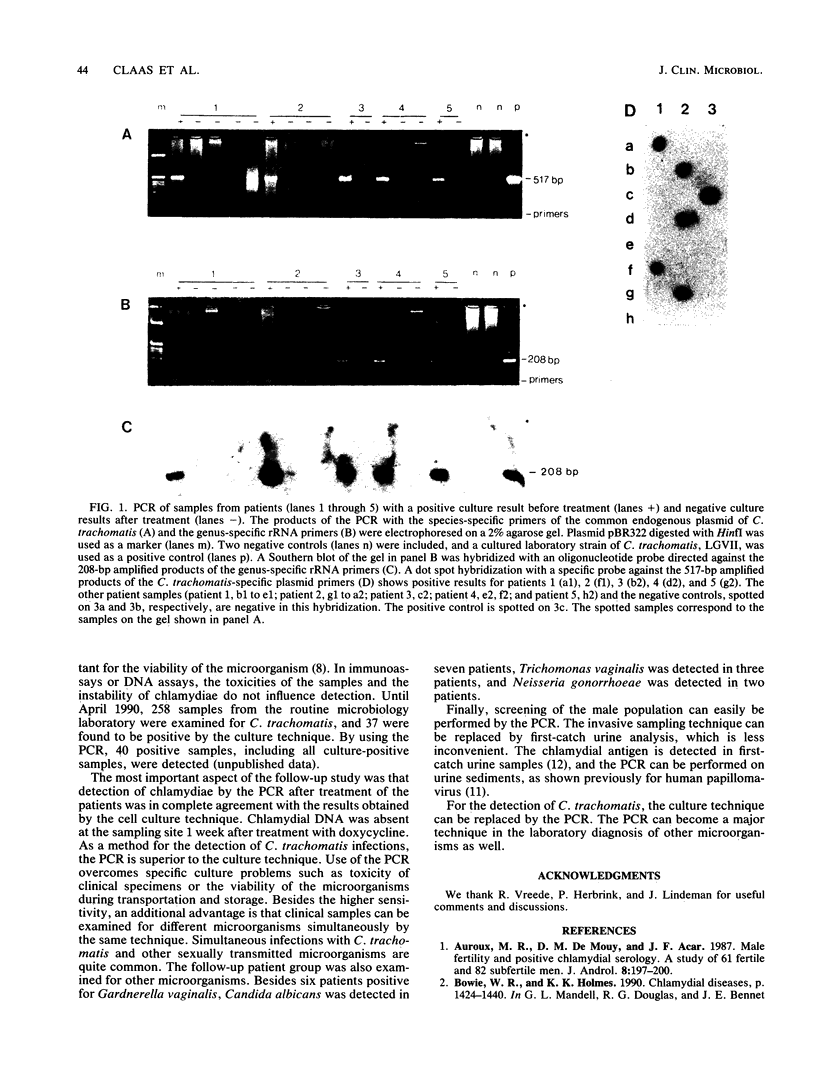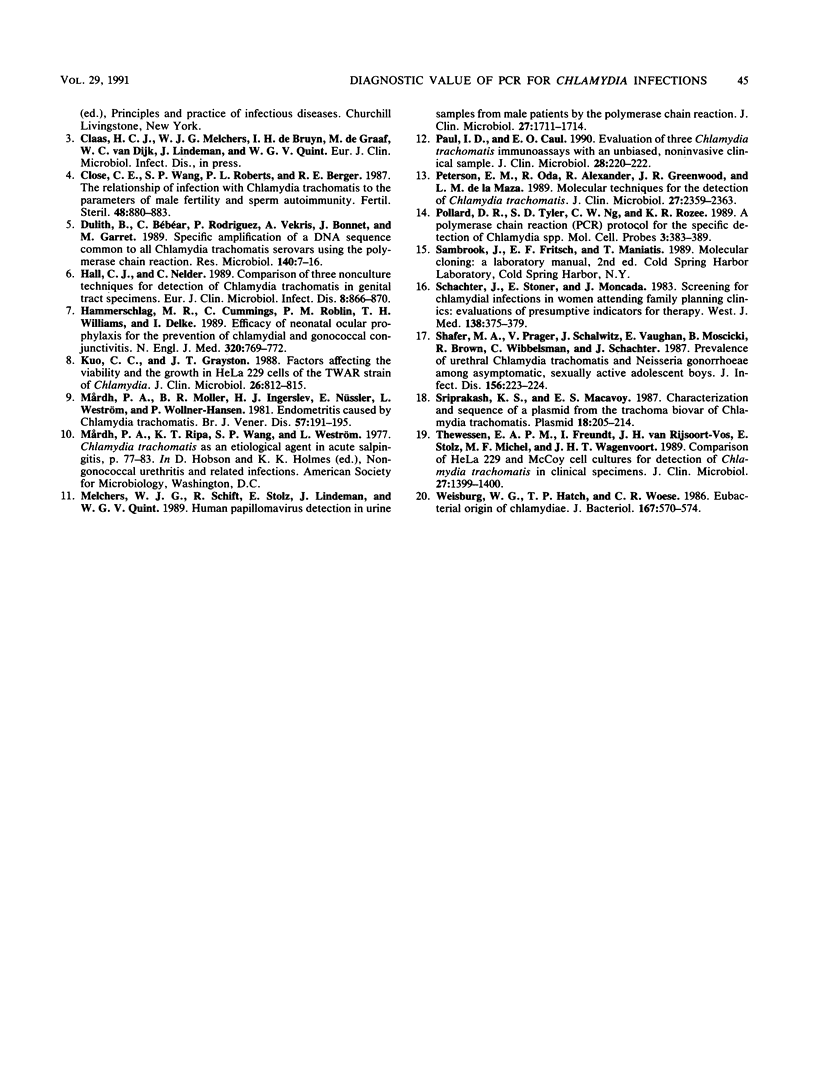Abstract
The diagnostic value of the polymerase chain reaction (PCR) for detection of Chlamydia trachomatis in comparison with that of the culture technique was established in a follow-up study of 32 patients (81 samples) who were treated for a C. trachomatis infection. The PCR was performed with two different sets of primers, a genus-specific primer set directed against the rRNA genes and a C. trachomatis-specific set directed against the common endogenous plasmid. After treatment with doxycycline, all patients became culture negative after 1 week. Results for the detection of C. trachomatis by the PCR were in complete agreement with the results by the culture method of detection, except for one culture-negative sample, which was found to be positive by the PCR. The results indicated that 1 week after treatment, no residual chlamydial DNA was found in the samples. Therefore, the PCR can be used for monitoring infections by chlamydiae.
Full text
PDF



Images in this article
Selected References
These references are in PubMed. This may not be the complete list of references from this article.
- Auroux M. R., De Mouy D. M., Acar J. F. Male fertility and positive Chlamydial serology. A study of 61 fertile and 82 subfertile men. J Androl. 1987 May-Jun;8(3):197–200. doi: 10.1002/j.1939-4640.1987.tb02431.x. [DOI] [PubMed] [Google Scholar]
- Close C. E., Wang S. P., Roberts P. L., Berger R. E. The relationship of infection with Chlamydia trachomatis to the parameters of male fertility and sperm autoimmunity. Fertil Steril. 1987 Nov;48(5):880–883. doi: 10.1016/s0015-0282(16)59549-1. [DOI] [PubMed] [Google Scholar]
- Dutilh B., Bébéar C., Rodriguez P., Vekris A., Bonnet J., Garret M. Specific amplification of a DNA sequence common to all Chlamydia trachomatis serovars using the polymerase chain reaction. Res Microbiol. 1989 Jan;140(1):7–16. doi: 10.1016/0923-2508(89)90053-3. [DOI] [PubMed] [Google Scholar]
- Hall C. J., Nelder C. Comparison of three non-culture techniques for detection of Chlamydia trachomatis in genital tract specimens. Eur J Clin Microbiol Infect Dis. 1989 Oct;8(10):866–870. doi: 10.1007/BF01963772. [DOI] [PubMed] [Google Scholar]
- Hammerschlag M. R., Cummings C., Roblin P. M., Williams T. H., Delke I. Efficacy of neonatal ocular prophylaxis for the prevention of chlamydial and gonococcal conjunctivitis. N Engl J Med. 1989 Mar 23;320(12):769–772. doi: 10.1056/NEJM198903233201204. [DOI] [PubMed] [Google Scholar]
- Kuo C. C., Grayston J. T. Factors affecting viability and growth in HeLa 229 cells of Chlamydia sp. strain TWAR. J Clin Microbiol. 1988 May;26(5):812–815. doi: 10.1128/jcm.26.5.812-815.1988. [DOI] [PMC free article] [PubMed] [Google Scholar]
- Melchers W. J., Schift R., Stolz E., Lindeman J., Quint W. G. Human papillomavirus detection in urine samples from male patients by the polymerase chain reaction. J Clin Microbiol. 1989 Aug;27(8):1711–1714. doi: 10.1128/jcm.27.8.1711-1714.1989. [DOI] [PMC free article] [PubMed] [Google Scholar]
- Mårdh P. A., Møller B. R., Ingerselv H. J., Nüssler E., Weström L., Wølner-Hanssen P. Endometritis caused by Chlamydia trachomatis. Br J Vener Dis. 1981 Jun;57(3):191–195. doi: 10.1136/sti.57.3.191. [DOI] [PMC free article] [PubMed] [Google Scholar]
- Paul I. D., Caul E. O. Evaluation of three Chlamydia trachomatis immunoassays with an unbiased, noninvasive clinical sample. J Clin Microbiol. 1990 Feb;28(2):220–222. doi: 10.1128/jcm.28.2.220-222.1990. [DOI] [PMC free article] [PubMed] [Google Scholar]
- Peterson E. M., Oda R., Alexander R., Greenwood J. R., de la Maza L. M. Molecular techniques for the detection of Chlamydia trachomatis. J Clin Microbiol. 1989 Oct;27(10):2359–2363. doi: 10.1128/jcm.27.10.2359-2363.1989. [DOI] [PMC free article] [PubMed] [Google Scholar]
- Pollard D. R., Tyler S. D., Ng C. W., Rozee K. R. A polymerase chain reaction (PCR) protocol for the specific detection of Chlamydia spp. Mol Cell Probes. 1989 Dec;3(4):383–389. doi: 10.1016/0890-8508(89)90017-0. [DOI] [PubMed] [Google Scholar]
- Schachter J., Stoner E., Moncada J. Screening for chlamydial infections in women attending family planning clinics. West J Med. 1983 Mar;138(3):375–379. [PMC free article] [PubMed] [Google Scholar]
- Shafer M. A., Prager V., Shalwitz J., Vaughan E., Moscicki B., Brown R., Wibbelsman C., Schachter J. Prevalence of urethral Chlamydia trachomatis and Neisseria gonorrhoeae among asymptomatic, sexually active adolescent boys. J Infect Dis. 1987 Jul;156(1):223–224. doi: 10.1093/infdis/156.1.223. [DOI] [PubMed] [Google Scholar]
- Sriprakash K. S., Macavoy E. S. Characterization and sequence of a plasmid from the trachoma biovar of Chlamydia trachomatis. Plasmid. 1987 Nov;18(3):205–214. doi: 10.1016/0147-619x(87)90063-1. [DOI] [PubMed] [Google Scholar]
- Thewessen E. A., Freundt I., van Rijsoort-Vos J. H., Stolz E., Michel M. F., Wagenvoort J. H. Comparison of HeLa 229 and McCoy cell cultures for detection of Chlamydia trachomatis in clinical specimens. J Clin Microbiol. 1989 Jun;27(6):1399–1400. doi: 10.1128/jcm.27.6.1399-1400.1989. [DOI] [PMC free article] [PubMed] [Google Scholar]
- Weisburg W. G., Hatch T. P., Woese C. R. Eubacterial origin of chlamydiae. J Bacteriol. 1986 Aug;167(2):570–574. doi: 10.1128/jb.167.2.570-574.1986. [DOI] [PMC free article] [PubMed] [Google Scholar]



